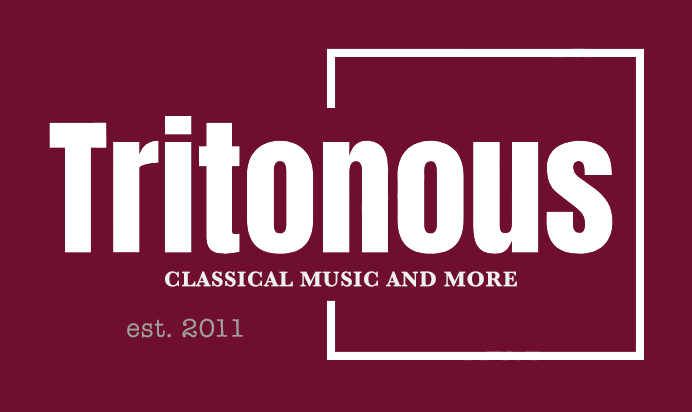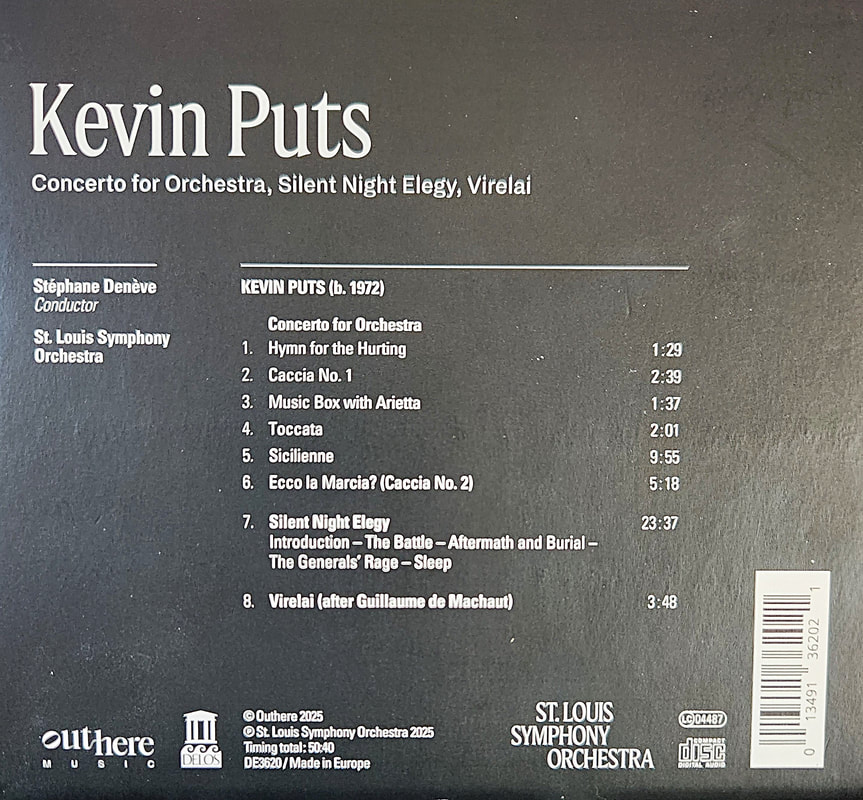So, from what I’m seeing so far, the relaunch of the Delos label is not particularly promising. But landing a recording contract with the St. Louis Symphony and their wonderful conductor, Deneve, is encouraging. So I sat back for a nice listen. And it really is a very nice listen. I just wish it had gone on a bit longer.
I read with interest in the booklet that both Puts and Deneve are bigtime fans of John Williams.1 So it isn’t surprising that Puts’ Concerto for Orchestra, written at the request of (and for) Deneve, displays the very essence of John Williams everywhere in the score.2
It is laid out in 6 movements, the first 4 of which are very short, the final two much more expansive and substantive. And right from the very beginning, Puts’ Hymn (for the Hurting) is very much like John Williams’ Hymn (to the Fallen). And it’s all good; it’s like being reacquainted with an old friend. And I hear beautiful recorded sound – from the strings, silky and airy at first, then building with texture and intensity in the soaring lines at the climax; and brass which are not too golden, but ring out resplendently with bite and sonority, as if right out of a glorious John Williams (JW) soundtrack.
Articulate woodwinds and lots of percussion inhabit the 1st “Caccia” (a 14th-century hunting song) which follows. And lots of horns too. And we encounter a profusion of familiar similarities to many JW scores too numerous to mention, but two come prominently to mind – Harry Potter and Indiana Jones (the motorcycle scherzo). The “Music Box” section is more atmospheric, and Puts reveals a more individual, distinctive voice, with gorgeous woodwind solos conversing back and forth among themselves. While the “Toccata” is a terrific little scherzo, with a whirlwind of scalic flourishes on woodwinds and strings, before blazing brass and a full battery of percussion (including the splendid use of xylophone and marimba) take us firmly to classic Star Wars territory. And I’m beaming hearing the resemblance. If only Puts had developed it more; I didn’t want this to end. (It lasts just 2 minutes.)
The mood is instantly subdued in the 5th movement, “Sicilienne”, beginning with a touch of Schindler’s List in the strings, followed by a melancholy piano solo which reminds us even more of JW’s wonderful score for Angela’s Ashes. The piano is soon joined by various woodwind solos – furtive double reeds, then flute and clarinet – quoting the opening hymn. Puts develops it much further, blooming into a majestic, expressive outpouring of emotion, again somewhat similar to JW’s Saving Private Ryan. This is quite an expansive piece of writing, personal and heartfelt, lasting a full 10 minutes. It is very moving and very memorable – so much so, I found myself humming it for the rest of the day. (Always a good sign.)
The final “Caccia” (#2) begins similarly. But no sooner than it begins, piccolos and snare drum (with a hint of 1941) lead us abruptly into a quirky little romp, and into the world of some later Star Wars music (Phantom Menace, maybe?), complete with whooping horns and blasting trumpet fanfares. Puts’ orchestration prowess is in full bloom, with glittering woodwind interjections darting atop brass and percussion exclamations, surrounded by string flourishes. John Williams would certainly be proud! (And I hope he has a chance to hear this at some point before it’s too late.)
This piece was enormous fun to listen to, with so many fleeting snippets of familiar John Williams scores I couldn’t always put my finger on exactly which one I was reminded of. But Puts isn’t merely imitating or copying; he’s obviously inspired by it. And that’s the highest compliment one composer can give another. Moreover, Puts has his own individuality, displaying inspired creativity and heartfelt expressiveness along with colorful and highly effective orchestration. And Deneve brings it all to life brilliantly (what a fantastic conductor he is, every time I hear one of his recordings), and the orchestral playing is dazzling. I do wish that Puts had expanded the first 4 movements into something more substantial. They’re over hardly before they even begin, and I wanted more from each of them. (The entire Concerto lasts just over 20 minutes, nearly half of that taken up by Sicilienne alone.)
Next is Silent Night Elegy (mercifully not that “Silent Night”) in an orchestral setting of music from Puts’ 2011 opera of the same name. There are 5 (or 6) distinct sections, and I was initially disappointed the production doesn’t individually track each one, instead confining the entire 24-minute suite into just one track. But in the end, it didn’t really matter, because the music is so involving, I was captivated and engaged for the entirety of it, and forgot all about such technical matters.
The opening horn solo of the “Introduction” is instantly reminiscent of JW’s score to JFK, tinged with the melancholy of Sleepers. But Puts soon takes off in different directions, developing the music into something completely different, and all thoughts of John Williams fade away. The “Battle” sequence, announced by piccolos and snare drum, marches into action propelled by heavy percussion, with dissonant, deep brass depicting the horror of it. It is soon followed by some impressively vigorous downbow strings en masse played with real muscle, and mighty percussion effects – all of which are extremely effective and musically descriptive.
The “Aftermath” continues with more angry music – and I begin to wonder how all of this comes from an opera. With so much of this music played ff by a powerful orchestra in full cry, I can’t imagine singers somehow being involved with it, competing to be heard.3 But never mind; as purely orchestral music, this is quite arresting. The “Burial” which immediately follows is a welcome respite from the discord – atmospheric and more lyrical, featuring a variety of orchestral solos (horn, trumpet, flute) and impassioned string writing. But it doesn’t last long, as more angry, brass-laden fierceness charges into the “Generals’ Rage”. And Puts doesn’t hold back with it – nor does Deneve, demonstrating his orchestra has the percussion and brass chops for just about anything. (And again I wonder how this could ever be sung to.) I don’t mean to imply this music sounds deliberately atonal or ugly. It doesn’t, and it isn’t. It’s musically descriptive and, most of the time, tonal. But a lot of this music is indeed angry and mildly unpleasant, especially for a piece entitled “Elegy”.
At last, “Sleep” comes in the still of the night. This final section is tranquil, calm and quiet, featuring a lovely tune on the strings, which here sound silky and airy, adorned with a gossamer sheen to their body of tone. And as it progresses, the elegy of the title reveals itself and closes the work peacefully. And all is well.
But then…why would they append at the very end of the program a rousing little march like his Virelai? As high-spirited as it is, it is particularly unwelcome coming after the quiet, prayerful serenity of Silent Night. It is inconceivable being placed here – with its piccolos and percussion leading a rather Beethovian marching processional. Oh it’s a wonderful little crowd-pleaser, written specifically for Deneve’s inaugural concert with the St. Louis Symphony. It’s a charming, energetic march of sorts, based on a 14th-century tune, and I’m sure the audience in St. Louis welcomed it, along with their new conductor, with open arms. But for a CD production, placing it after Silent Night is simply ridiculous. It would have been a terrific concert opener however, if only someone had thought of that.
Grumbles aside, this program is musically rewarding and enormously entertaining. And it is gratifying to hear Deneve doing great things with this great orchestra.
A quick comment about the recorded sound. It’s generally very good, despite an occasional touch of fierceness in fortissimo passages in the Concerto for Orchestra. The booklet reveals these 3 works were recorded over a 4-year period – the latest being the Concerto (2023), which employed a different engineer. The earlier recordings (from 2019 and 2020) are largely free from this anomaly. Much more concerning is the overall short playing time and, especially, the price of this CD. These are significant issues that Outhere Music needs to address on future releases if the Delos label has any chance to be competitive and successful.
1 Which would explain all those terrific YouTube videos of Deneve conducting John Williams movie music with the St. Louis Symphony. He’s definitely got a flair for it.
2 What is surprising is that several British reviews of the piece make absolutely no mention whatever of John Williams. LOL.
3 It’s possible this orchestral suite draws from orchestral interludes more than from vocal passages.











